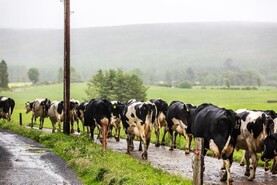Milk yields on the farm began to decline in the third week of July.
To prevent production from falling more, we reduced the amount of milk coming from fresh grass, taking it from maintenance plus 12l to maintenance plus 10l.
This change has stabilised the milk yield of the spring-calving batch, with these cows currently yielding 26l/cow/day at a feed rate of 0.25kg of meal per litre of milk.
As expected, milk yields in the autumn-calving batch continue to decrease as their drying-off period approaches. They are currently yielding 17l/cow/day at a feed rate of 0.18kg of meal per litre of milk.
For the rest of August and September, we will continue to dry off cows weekly.
Silage
A week after increasing feed rates and reducing the level of milk from fresh grass, we introduced silage into the cows’ diet.
Although buffering cows with silage throughout the grazing season is becoming more common, I prefer not to do this as it replaces high-quality fresh grass with a lower-quality alternative.
However, in July, when cows were being brought in to milk, we noticed that a number were stopping to eat roadside verges, including hawthorn hedges.
We consulted with a nutritionist about this pica-like behaviour, which can often be witnessed with cows licking concrete walls or drinking other cows’ urine (things of no nutritional value).
These other common pica behaviours were not obvious in our herd, so the grazing of the road verges was put down to the low dry matter in the fresh grass.
Cows were switched to a high-fibre nut, increasing the fibre content of the nut from 9% to 12%.
Despite this, the abnormal grazing behaviour persisted, particularly on days with heavy rainfall.
Therefore, we decided to introduce a bale of silage daily to the milking cows’ diet in the hope of minimising the issue. While this has worked, unfortunately it has not led to an improvement in milk yields.
Plans ahead
As well as drying off cows in the autumn batch, we will also finish scanning the spring batch, with the plan to sell any animals that aren’t pregnant.
This will help reduce pressure on the grazing platform and allow us to build up grass in the hope of extending the grazing season into the autumn, weather permitting.
We also plan to clean and disinfect all calving areas and calf pens in preparation for the autumn calving season, while some improvements are due to be made in the parlour once we are down to just over 50% of the herd milking in September. It promises to be a busy few months ahead.






 This is a subscriber-only article
This is a subscriber-only article










SHARING OPTIONS: